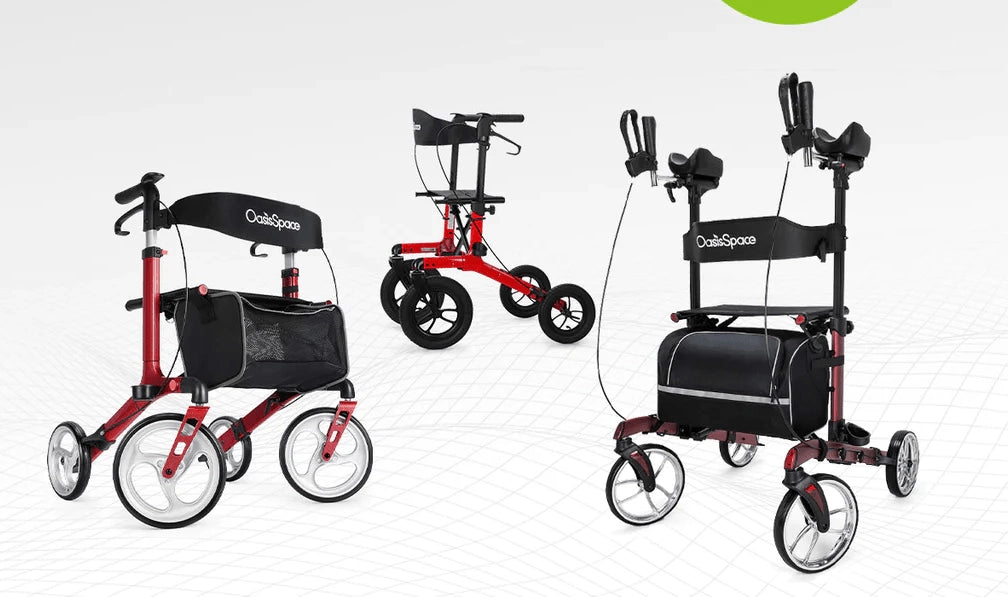
Guide to Select the Right Walking Assistance Device for Older Adults
There are a number of walking assistance gadgets and mobility equipment available on the market today that are meant to support senior individuals who have trouble moving about securely.
Given that the risk of falling significantly rises with age and that falls may have serious consequences, it is not surprising that various types of assistive devices have been created to help senior individuals with diverse needs.
To the point where, although it's true that everyone may find mobility assistance or walking gadgets to suit their requirements, many people have trouble even knowing where to begin.
Starting with the basic cane, the mobility aid business has come a long way to include crutches, scooters, rollators, wheelchairs, and much more.
To be quite honest, there are so many alternatives out there for walking aids that it might be overwhelming to begin your search.
Fortunately, we have compiled a list of all the most prevalent styles of walking aids for the aged now on the market. Here, we'll introduce you to the design of these popular categories and explain how they may benefit you.
Canes

A cane may be the ideal choice if you only need a bit of help maintaining your balance and stability when walking on your own.
If you're experiencing discomfort in your legs, knees, ankles, hips, etc., a cane may assist you to shift your body weight, which can alleviate some of the pain.
Canes come in a variety of styles, but they all serve the same purpose: to aid the user in maintaining their balance and standing upright while reducing strain on the lower limbs.
Crutches
Crutches and canes complement one another since they both let the user shift part of their body weight away from their legs and onto their upper bodies.
Crutches are far more challenging to handle than regular canes, which is why older adults often use them in pairs.

They work best as a short-term solution for moving about following an injury to the leg. To effectively handle crutches, you require both upper body strength and coordination. As a result, they are not a good choice for elderly people who are frail.
Knee Walkers
If you have just had surgery or injury to your knee or ankle and are having difficulty walking, a knee walker may be a helpful substitute for crutches throughout your recovery.

These mobility devices, which may be used while wounds are healing and are also known as leg walkers or leg cruisers, are meant to increase autonomy.
Unlike crutches, which demand extensive upper-body strength, a knee walker requires little to none, reducing the risk of back pain and weariness.
Folding Walkers
Folding walkers, as the name suggests, may be folded up quickly and effortlessly for travel.
Normally, this device will have a two-button design for folding it up. With a simple push of the button, this device can be folded up and stored compactly, making it suitable for transport by vehicle, train, or aircraft.
Hemi Walkers
A person using a Hemi walker may be leaning in one direction for stability. It's made for those who have limited mobility in only one arm.
It seems natural that it would weigh around half as much as a full-sized folding walker because it appears like 1/2 of one.
Hemi walkers are regarded as more steady than a walking stick, thus they undoubtedly have their place in the market.
Rollators
Rollators are comparable to wheeled walkers in that they feature a frame, tires, as well as a seat, but they also get a different set of handlebars.
You should give this some thought if you spend a lot of time traveling or moving about the neighborhood.
But if you want to lean on the devices for a break, and you haven't placed the brake, it might go away and cause severe harm if you're not cautious.
Mobility Scooters
These scooters may seem like wheelchairs, but they are larger, heavier, battery-operated, and controlled by steering wheels.
In reality, mobility scooters are more accurately described as "walking substitution equipment" than "assistive devices".
However, they may be a lifesaver for those who experience problems moving about but still desire to view the sights and participate in group activities.
Upright Walkers

The wheel structure of both the rollator and the upright walker are strikingly similar while the handles are the distinguishing feature.
In contrast to a rollator, the handlebars of an upright walker are placed higher on the body, exactly behind the user's elbows.
Because they encourage a more natural, erect position, they may be useful for reducing back discomfort. Some individuals prefer the stability and security of an upright forearm walker to that of a standard walking device.
Manual Wheelchairs
Those who employ manual wheelchairs propel themselves with their hands instead of a motor. The rider moves the chair ahead, back, and turns by grasping the handles located on each side of the wheels.
And if the wheelchair rider has a companion, that companion may propel them with a manual wheelchair by walking behind them. This is why manual wheelchairs usually feature grips on the rear of the seat.
Powered Wheelchairs
To go ahead, a powered-wheelchair user operates a motor that charges batteries.
Tiredness is no longer a concern, and those with impairments who have trouble pushing a manual wheelchair may utilize this powered one instead.
When the effort required to propel a manual chair would make further travel impossible, motorized wheelchairs provide a welcome alternative.
All-Terrain Wheelchairs
There is a wide variety of all-terrain wheelchairs available, each with its own range of motion. Many of these devices have the size and capability that could surprise you.
Larger wheels and longer frames are only two of the ways that all-terrain wheelchairs help users stay stable on rugged terrain. Some versions even have tank treads for crushing through tough terrain.
Users have an advantage when they go for a ride outside thanks to the balloon-style wheels and more cushioning.
It's recommended to prevent problems while using walking assistance by first consulting with your doctor. As you don't want to wind up with anything that doesn't aid in your recuperation, the procedure begins with a comprehensive diagnostic of your present mobility limitations.
Keep in mind that in addition to this, you will have to become acclimated to the temporary walking pattern, which could take many months. Most essential, keep in mind that physical activity is a vital part of your healing process. Keeping your legs active and supporting your body weight while your gait is being progressively restored is critical, which is why you need walking assistance.




